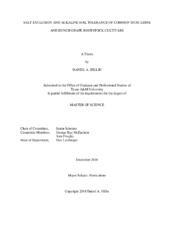| dc.description.abstract | Bunch grapes (Vitis spp.) are classified as moderately salt tolerant. However, little is known about the salt tolerance of muscadine (Vitis rotundifolia) grapes. The objective of this research was to evaluate the salt exclusion capacity of muscadine grapes relative to common bunch grape rootstocks and own-rooted hybrids. In two separate experiments, 31 muscadines, 6 bunch grape rootstocks, and 5 own-rooted hybrid cultivars were irrigated daily with a 25mM NaCl salt solution for a period of 14 days and destructively harvested to determine Na^+ and Cl^- concentrations in roots and shoots. At harvest, leaf necrosis was rated on a scale of 0 to 4. In greenhouse test one and two, Blanc Du Bois accumulated higher concentrations of both Na^+ and Cl^+-, but with lower leaf necrosis ratings than all six rootstock cultivars. Own-rooted hybrid and muscadine cultivars exhibited a greater range of accumulation of Na^+ and Cl^- than the rootstocks, and generally had higher ratings of leaf necrosis. The muscadine cultivar Janebell displayed generally lower concentrations of both Na^+ and Cl^- than most other muscadine cultivars, and overall there was no clear separation between the exclusion capacity of the muscadines and bunch grape rootstocks.
To evaluate the relative alkaline soil tolerance of muscadines, 31 muscadine cultivars, 6 bunch grape rootstock cultivars, and 5 own-rooted hybrids were evaluated under field conditions in an alkaline (pH 8.2) Weswood silt loam soil. At the end of the growing season, tissue samples were collected from each cultivar for nutrient analysis. Significant differences in Na^+ and Cl^- exclusion capabilities between some muscadine and rootstock cultivars were observed, although the salinity of the soil and irrigation water were within recommended ranges for commercial grape production. All six rootstock cultivars exhibited generally higher rates of vigor than the muscadines under field conditions. The hybrid cultivars Blanc Du Bois and Dunstan’s Dream accumulated higher concentrations of Cl^- than the rootstocks but did not have high marginal necrosis ratings. This research suggests that Blanc Du Bois may benefit from grafting on sites where salinity is limiting, and that muscadines are not less salt tolerant than bunch grapes. Furthermore, the range in salt exclusion capacity observed in the muscadines under study suggest that grafting may be a viable option for muscadine growers when salinity is thought to pose a risk. | en |


